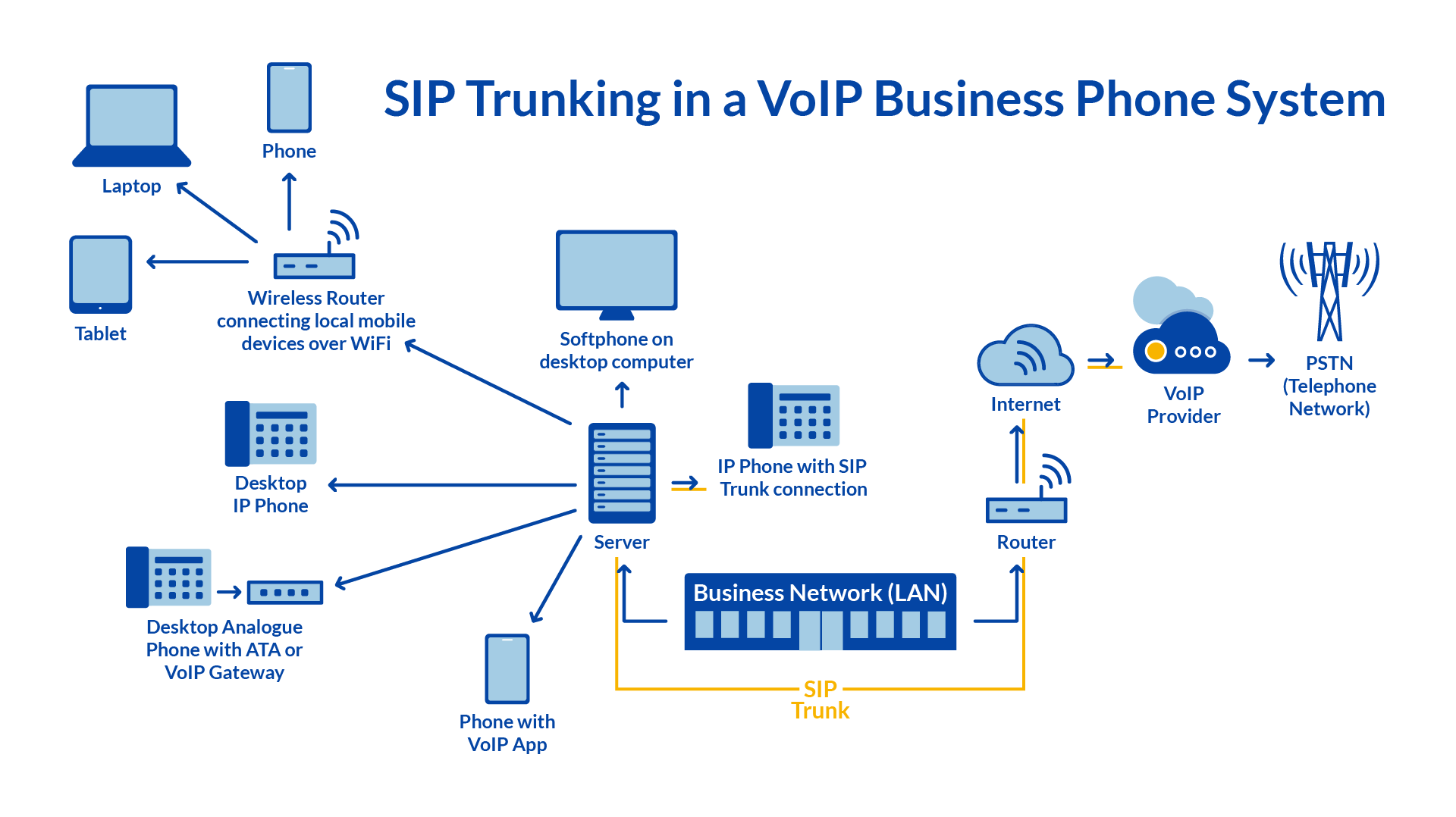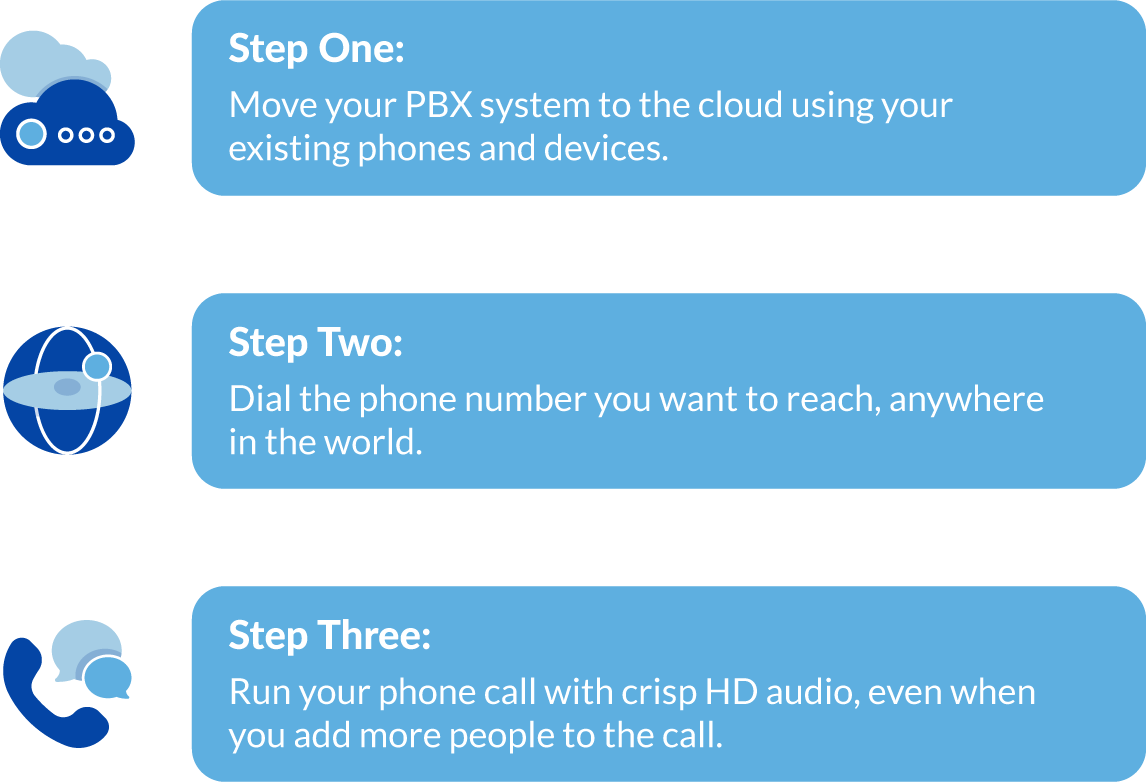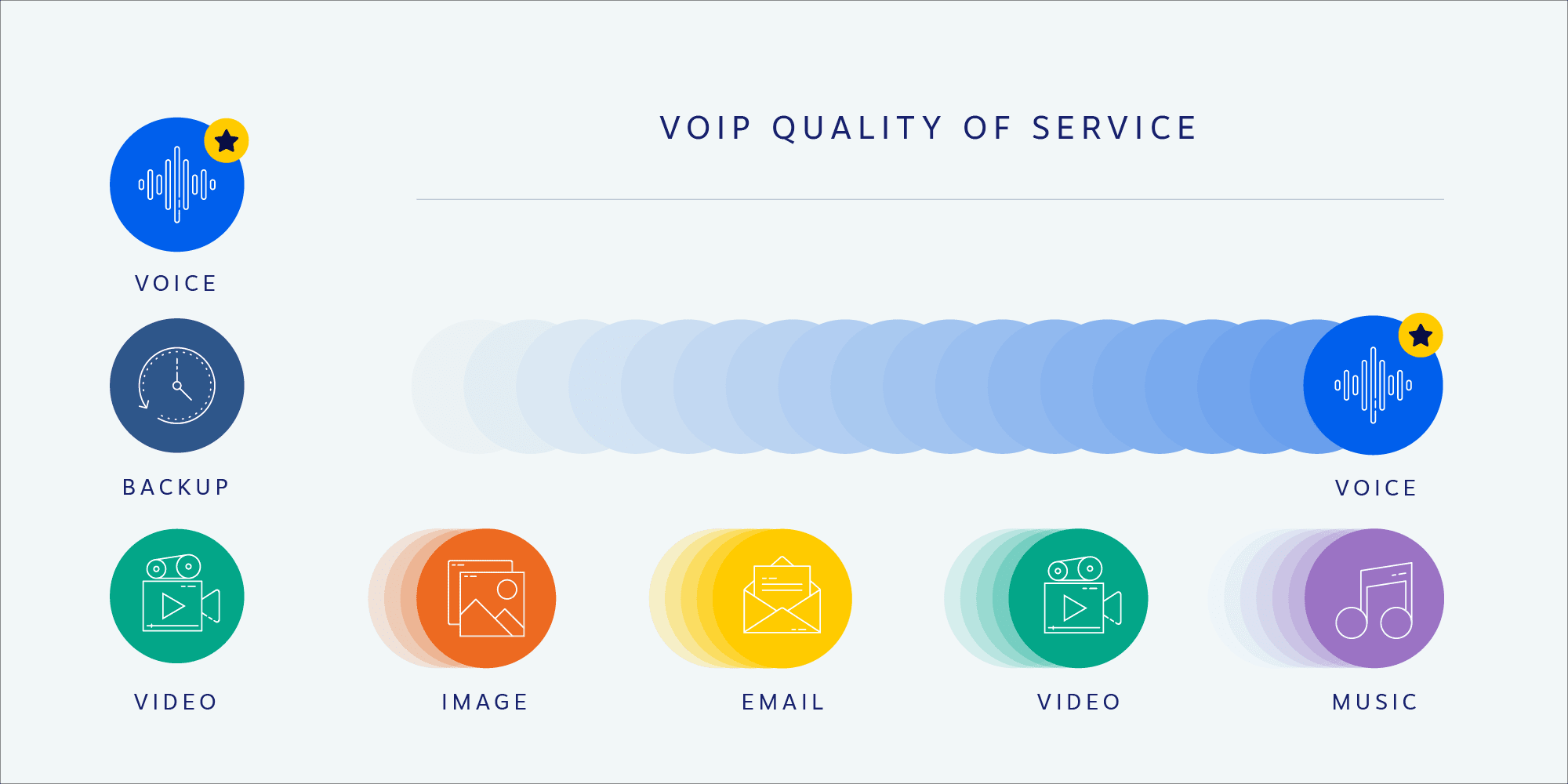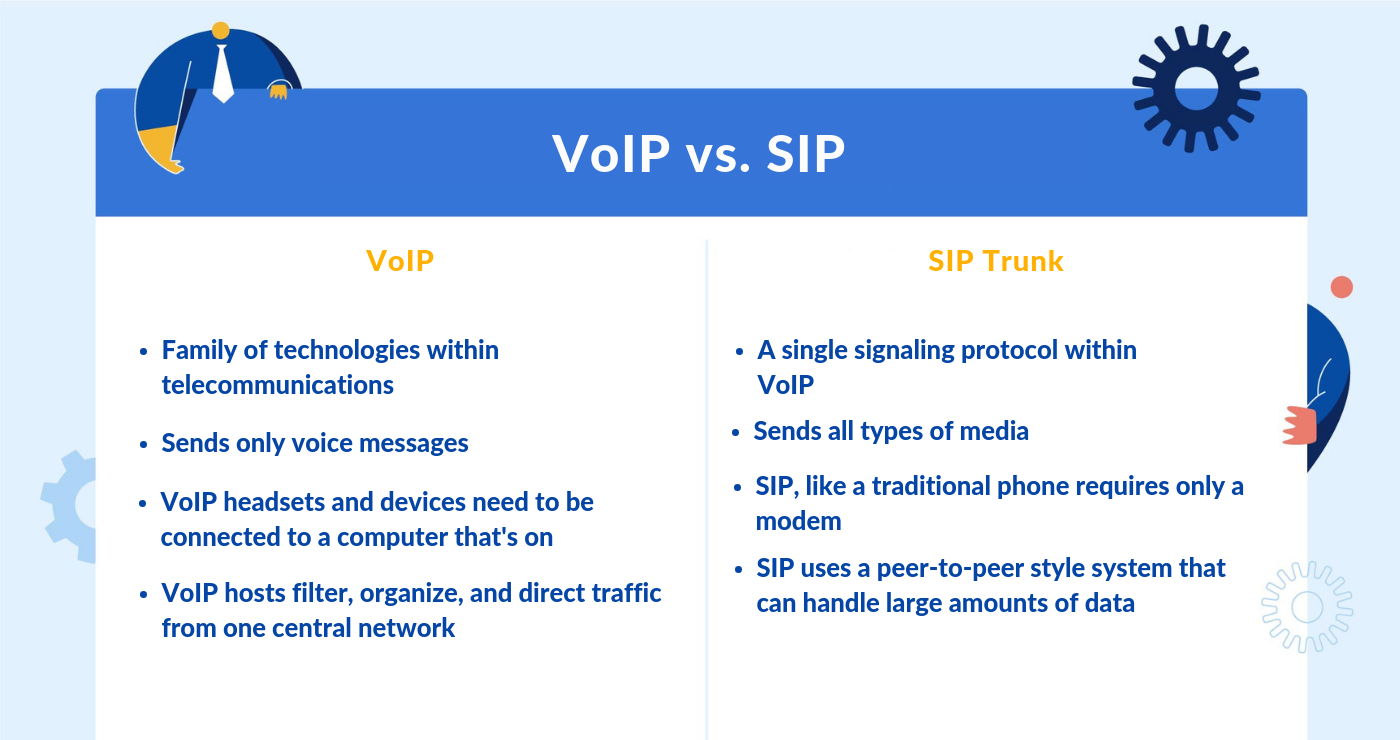What Is SIP Trunking?
SIP (Session Initiation Protocol) trunking is a modern technology that enables voice and multimedia communications over an internet protocol (IP) network instead of traditional phone lines. It uses SIP, an application-layer protocol, to establish, modify, and terminate communication sessions between two or more endpoints.
The term “trunking” refers to the consolidation of multiple communication channels or lines into a single, logical connection or “trunk.” SIP trunks provision Voice over Internet Protocol (VoIP) connectivity between an on-premise phone system and the public switched telephone network, also known as PSTN.
For instance, an office might have an existing PBX for phone service. SIP trunks provide phone service for the entire office so they can reach the outside world.
Running your small business phone system through SIP trunking is affordable, but it’s not necessarily for everyone. It replaces the need for physical lines. It also lets you easily add new phone lines or modify your phone service without disruptions or the need to buy new hardware.
If you’re still unsure about SIP trunking, Tom from Nextiva gives a great explanation in this 2-minute video:
SIP trunking can revolutionize your business by letting you upgrade your PBX to an internet-powered phone system.
It operates similarly to HTTP, which is the very basis of browsing web pages on the internet. SIP was embraced by the open-source community and acted as a catalyst for business phone service. Also, SIP’s capabilities extend beyond phone service into broader messaging functions.
Just like you’d get a traditional phone line subscription from a landline provider, SIP trunking is provided by a SIP provider.
Get your business phone system. Simple. Affordable.
Get your business phone, messages, video meetings, contact management and notes–integrated in ONE powerful app.
An excellent SIP trunking service lets you use your existing PBX equipment to transition into an internet-powered telephone network.
And that’s not all: you can also use a SIP phone as part of your unified communications system. You can synchronize all your communication channels in real time. This way, you’ll enhance productivity, collaboration, and efficiency across your company.
How Does SIP Trunking Work?
SIP trunking works as an intermediary between your business phone system and the Internet Telephony Service Provider (ITSP). See the diagram below showing how calls flow from a SIP phone (VoIP) in a business to the outside world — it’s fascinating!

SIP trunking replaces traditional phone lines with a virtual connection, allowing your business to make and receive calls using your existing internet connection. It acts as an intermediary between your on-premise phone system (PBX) and the Internet Telephony Service Provider (ITSP) that delivers your service.
Think of it this way: traditionally, businesses relied on physical phone lines to connect calls. SIP trunking bypasses these lines by converting voice calls into digital data packets that travel over your internet network. This eliminates the need for expensive installations and clunky hardware.
Transitioning to SIP trunking
Here’s what you’ll typically need to make the switch to SIP trunking:
- Reliable Internet Connection: Since calls travel over your internet, a stable and high-speed connection is crucial for clear call quality.
- SIP-compatible PBX System: Your PBX acts as the brain of your phone system. Ensure it’s compatible with SIP technology, or you may need an upgrade. Some providers offer hosted PBX solutions, eliminating the need for on-premise hardware.
- VoIP Phones or Adapters: For making and receiving calls, you’ll need phones that work with SIP technology (VoIP phones). Alternatively, if you prefer to keep your existing phones, SIP adapters can convert them for use with VoIP calls.
- Network Connection for Phones: While voice calls travel over the internet, your phones themselves might still require a separate network connection for features like internal calls and intercom functionality.
Direct inward dialing (DID) numbers: Enhancing flexibility
DID numbers are an additional feature you can leverage with SIP trunking. They provide a cost-effective way to assign specific phone numbers to employees or departments within your company.

Here’s how it works:
- Your ITSP assigns you multiple phone numbers, each linked to a specific SIP extension within your PBX system.
- Incoming calls with a specific DID number automatically route to the designated extension, eliminating the need for a receptionist or auto-attendant.
- The beauty of SIP trunking with DID is the elimination of separate phone lines for each number. You only pay for the service itself, reducing infrastructure costs.
Using DID numbers with SIP trunking, you can enhance call management for various departments like customer service, sales, or even individual employees, improving overall communication efficiency.
What Is SIP Trunking Used For?
The main role of SIP trunking is to replace PRI technology. PRI, or Primary Rate Interface, has been used for decades to deliver lines of voice and data using physical copper lines.
Essentially, it’s a bundle of analog phone lines put together. PRI can be costly to maintain since the hardware is becoming outdated rather quickly.
With SIP trunking, this happens using VoIP technology. SIP also supports other data like instant messages and video conferencing.
SIP trunking is the right choice for anyone ready to move their business communication on a light budget.
This warrants a follow-up question: how will you know that your company is ready for SIP?
Here are some questions to consider:
- Are you currently paying for call capacity that you don’t need?
- Is it expensive to maintain all your equipment?
- Do your voice calls drop unexpectedly or need higher reliability overall?
- Do you have remote employees and/or employees that travel or relocate often?

In short, SIP trunking is used for call setup, management, and teardown. It’s flexible, reliable, and quite lightweight. This means you can focus on your business instead of the technicalities. SIP is the basis for VoIP communications, and SIP Trunking is used to provide VoIP connectivity through a PBX.
Benefits of SIP Trunking
Still unsure of the advantages of this approach to your business communications? In this section, we’re diving into the benefits of SIP.
SIP connects a variety of devices to connect individuals and businesses locally and globally through voice, video, and text. It simplifies business communication systems and makes businesses technologically competitive. Here’s how.
1) Cost savings and efficiency
With a traditional phone line, you may be paying for extra lines you aren’t using. You might also incur high charges for long-distance and international calls.
There’s also the cost of equipment maintenance.
With SIP trunking, you’ll experience simplified pricing, usually charged on a per-user basis. This comes with the extra benefit of predictability in your recurring expenses.
You get the choice between metered and unmetered SIP trunk plans. There’s a huge difference.
2) Virtual presence
SIP creates a unified virtual presence. It allows individuals and businesses to choose when and how they would like to be available.
For example, if you’re in a business meeting, calls and messages can be forwarded to your assistant. If you’re on a business trip, they’re routed to a smartphone.
Thanks to SIP, you’ll have centralized communication. We all have multiple ways we communicate: multiple devices at home, just as many (or more) at work, texts, video chat…The list goes on. SIP grants a user one “address” for all these devices and applications.
As a result, your interactions remain frictionless, no matter where you are.
3) Space for growth and scalability
When you’re looking to grow your company, your business needs will change. Sometimes, they’ll change at a rapid pace.
You need your technology to grow your business. With SIP trunking, you’ll combine your communications across channels and multiple offices into a single network.
Your call volume or the number of concurrent calls is likely to grow as your company grows. Technology shouldn’t stop you from doing things right.
No need for new IP infrastructure or waiting to speak to a customer service agent just to add new phone lines! With SIP trunking, you’ll be able to do all of that on your own, on demand.
4) Reliable technology
Traditional telephony service can be disrupted due to phone failures, bad weather, or a damaged telephone pole.
Luckily, SIP trunking with VoIP boasts higher reliability. This means that you can keep using your phone even in case of failure. Calls can be routed to other lines, offices, or your mobile device.
No matter what happens in the background, you can keep your business going smoothly and interruption-free.
Drawbacks of SIP trunking
While SIP trunking offers many advantages over traditional telephony services, it also has some potential drawbacks that businesses should be aware of:
🌐 Dependence on internet connectivity
SIP trunking relies on your internet connection to transmit voice data. If your internet goes down, your phone system will be inoperable. This can be a major issue for businesses that depend heavily on reliable phone communications.
How to overcome it: Implement redundant internet connections from different providers, or use a backup like 4G/5G cellular data to ensure continual internet connectivity.
🎛 Quality of Service (QoS) issues
Since voice data travels over the public internet, latency, jitter, and packet loss can degrade call quality if the internet connection is not properly optimized for real-time communications.
How to overcome it: Implement QoS prioritization policies on your network equipment to prioritize voice data. Use a dedicated internet connection for SIP trunking traffic.

🔐 Security vulnerabilities
SIP communications are transmitted as data packets, making them vulnerable to interception and hacking if not properly secured.
How to overcome it: Use encrypted SIP trunks, and enable security features like firewall protections, authentication, and data encryption. Implement robust cybersecurity practices.
🔌 Power dependency
SIP phone systems require power to operate, unlike traditional analog phones that derive power from the telephone line.
How to overcome it: Deploy backup battery/generator power for SIP phones. Consider keeping analog phone lines for emergency use.
Being aware of these potential drawbacks and implementing appropriate solutions helps businesses mitigate the risks and take full advantage of the benefits of SIP trunking.
PRI vs. SIP Trunking vs. VoIP
While PRI, SIP Trunking, and VoIP are related technologies used in voice communications, they differ in their capabilities and implementation. Here’s a side-by-side comparison:
| Feature | PRI | SIP Trunking | VoIP |
|---|---|---|---|
| Technology | Traditional phone lines | Internet Protocol (IP) | Internet Protocol (IP) |
| Scalability | Limited, requires additional physical lines | Highly scalable, no physical line limitations | Highly scalable, no physical line limitations |
| Cost | Higher costs for maintenance and scaling | Lower costs, no physical line expenses | Lower costs, no physical line expenses |
| Mobility | Limited to physical locations | Supports remote workers and mobility | Supports remote workers and mobility |
| Features | Basic voice calling | Depends on the specific protocol used (e.g., SIP) | Advanced features like video conferencing, integration with business apps |
| Flexibility | Rigid, aging technology | Flexible, adaptable to changing needs | Flexible, adaptable to changing needs |
| Future-proof | May become obsolete as telecom providers phase out support | Future-proof as it uses IP networks | Future-proof as it uses IP networks |
- PRI uses traditional phone lines, making it inflexible, costly to scale, and potentially obsolete.
- SIP trunking and VoIP both use internet connectivity, offering cost savings, scalability, mobility, and advanced features.
- VoIP is a broad term for voice-over IP, while SIP trunking specifically uses the SIP protocol to enable VoIP calling.
For modern businesses, SIP trunking and VoIP solutions are generally more future-proof, cost-effective, and feature-rich compared to the aging PRI technology.

How To Get Started With a SIP Trunking Service
Getting started with a SIP trunking service doesn’t have to be complicated.
Who can benefit from SIP trunking?
SIP trunking is a valuable solution for businesses of all sizes, particularly those with:
- High call volume: SIP trunking can significantly reduce communication costs for businesses with frequent calls.
- A need for scalability: Businesses with fluctuating call needs can easily adjust their SIP channels.
- A desire for advanced features: SIP trunking unlocks a range of features that can improve communication efficiency.
Transitioning to a SIP trunking service is straightforward but requires some key steps. Here’s how to get started:
- Assess your needs: determine how many concurrent calls you need to support, decide if you want to keep your existing phone numbers, and consider any advanced calling features like auto-attendant, video conferencing, or call recording that are must-haves.
- Choose a SIP provider: With your requirements in mind, research reputable SIP providers that can support those needs at a reasonable cost. Make sure they’re compatible with your current PBX system or offer a hosted PBX solution. Also, check their uptime guarantees and customer support offerings.
- Prepare your network: Before making the switch, prepare your network infrastructure. Ensure your internet has enough bandwidth for VoIP calling and configure your router/firewall to allow the necessary SIP traffic. Setting up a dedicated voice VLAN or QoS rules to prioritize voice packets is recommended.
- Port your numbers (if applicable): If you’re keeping your existing phone numbers, you’ll need to request number porting from your current provider to the new SIP provider, which can take 1-3 weeks typically.
- Configure your system: Once the numbers are ported, configure the SIP trunk connection between your PBX and new provider, program your numbers, calling rules, auto attendant, and other settings, and thoroughly test inbound and outbound calling.
- Train your staff: Make sure to properly train your staff on using any new phone system features and provide instructions for things like making external calls through the new system.
With our plans, we give you all of the above control and power over your cloud PBX — and more.
We also have an award-winning customer service team to help you with anything you may need along the way.




